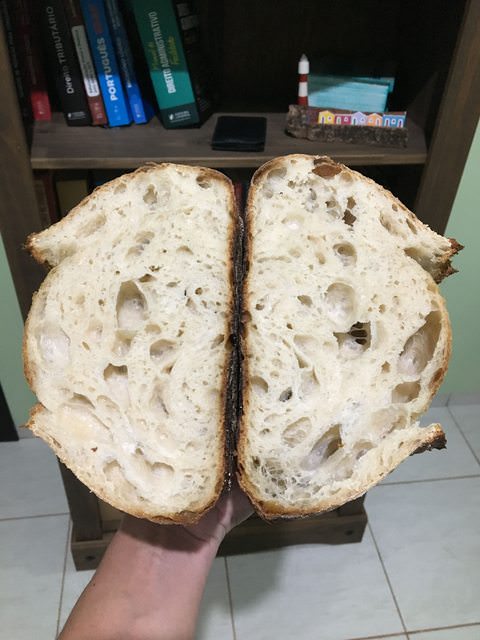
5 Grain Levain with Bulgur

I have been away from bread making for a month due to other obligations and this was the recipe that called out to my baker’s soul. ?
The last time I did this recipe, I used cracked rye and oat groats so I changed it to bulgur and old fashioned oats. I also changed the Wholewheat flour from Red Fife to Selkirk wheat. The bran was sifted out and used in feeding my starter to get it up to speed before making the final levain.
The procedure was also changed a bit as my curiosity was piqued when reading about putting the dough in the fridge at the end of the bulk fermentation. A few of you seem to be getting some amazing results. I do remember getting some really open crumbs when I have occasionally retarded the bulk in the middle of things due to an interruption of some sort, but I have never done this intentionally. And never for several hours!
Makes 3 loaves
Liquid Levain build
272 g Bread flour
343 g Water
55 g Starter (bran was used to refresh it at a 100 % hydration)
Soaker
100 g bulgur
100 g Flaxseeds
85 g Sunflower seeds
85 g old fashioned oats (large flake)
484 g Water, boiling
6 g Salt
Dough
533 g Unbleached flour
15 g Vital Wheat Gluten
274 g Sifted freshly milled Selkirk wheat flour
303 g Water
30 g yogurt (Greek because that is what I had on hand)
21 g Pink Himalayan Salt
All of the Soaker
650 g Levain
A couple of days or the morning before
- Main dough and levain prep: Mill 320 g of Selkirk berries and sift. Use 274 g of the sifted flour for the main dough and reserve the bran and the remaining few grams of sifted flour to revive or feed the starter prior to making the final levain.
- Soaker prep: Measure out the bulgur, and oats. Reserve. Grind the flax seeds coarsely in a Bullet or spice grinder. Add to the bulgur and the oats. Toasts the sunflower seeds and add to the bulgur, oats and flax. Add the 6 g of salt. Cover and reserve.
- Main dough prep: To the 274 g of sifted flour, add the unbleached flour, and the vital wheat gluten. Mix well to distribute the VWG. Cover and reserve.
The night before making the dough
- Levain: Twelve to sixteen hours before the the final mixing of the dough, put all of the ingredients together for the levain and keep covered at room temperature (73 F).
- Soaker: Add the boiling water to the soaker ingredients and cover. Leave to cool overnight at room temperature.
Final mix and bake
- Put the water and the yogurt for the dough in a bowl and add the soaker. Mix well to loosen the mass. Measure 650 g of the levain, add to water and soaker, and mix again. Add this mixture to the reserved flour mix and make sure to mix well to a shaggy dough. Autolyse for 60 to 75 minutes.
- My dough felt dry so I added another 50-60g of water with the salt. Mix well to integrate all ingredients and do several series of folds to begin developing the gluten. I initially did 50 folds, let rest 10 minutes, do another 10 or so folds, rest 10 more minutes ad do another 5 or 6 folds.
- Bulk ferment the dough at room temperature and do folds every half hour until the dough has risen about 30%. This took 2 hours at 73F.
- Place in the fridge for 4-5 hours. I left mine for 4.5 hours in a 37F fridge. The dough rose to just about double.
- Pour the dough out onto a bare counter and divide into 3 loaves. Lightly flour the top of the portions and gently round into boules using a dough scraper. This was much easier than usual because of the cold dough.
- Let rest 45 minutes. Do a final shape by cinching and rounding the dough with a scraper to make a fairly tight boule, but without deflating the dough. Place seam side down in rice/ap floured bannetons and cover. Let rise on the counter for an hour and then put to bed in the fridge for the night.
- The next morning, pre-heat the oven and the Dutch ovens to 475F. Place parchment rounds in the bottom of the pots and place the dough in seam side up. Score if you wish. I chose not to. Cover and bake for 25 minutes at 450F. Remove lids and bake for another 25 minutes at 425F or until the inside temperature is 205 F or or more.

The loaves had pretty good but not fantastic oven spring. That being said, I got great ears even though I didn’t score the dough. Crumb shots to come later when they cool. That’s the first batch to come out of the oven. I have a second batch of six and a batard to go in as soon as the oven is back up to temp.
































